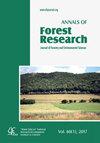熊果木的系统发育分析。在杨柳科中使用完整的叶绿体基因组序列
IF 1.7
3区 农林科学
Q2 FORESTRY
引用次数: 2
摘要
作为杨柳科中一种独特的濒危物种,熊果木(Chosenia arbitifolia(Pall.)a.Skv。在装饰和工业用途上具有巨大的应用潜力。尽管其具有综合重要性,但杨柳科中熊果苷的系统发育地位仍然不明确。在本研究中,对熊果苷的叶绿体全基因组进行了测序,并与其他杨柳科物种的基因组进行了比较。基于最大似然(ML)方法建立了系统发育树。从头组装为C.arbitifolia的完整cp基因组产生了155684bp的长度,包括84551bp的大单拷贝区、16217bp的小单拷贝区和27458bp的两个反向重复区。总共预测了130个基因,其中85个蛋白质编码基因在五个参考数据库中的至少一个数据库中进行了注释。在重复序列分析中,鉴定了23个正向、15个回文、一个互补、一个反向长重复和221个推定的SSR。基因组比较结果表明,大单拷贝区(LSC)比小单拷贝区和反向重复区(IR)更具分化性,非编码区的分化程度高于编码区。在IR-LSC/SSC边界处也观察到显著的收缩或扩张。对20个杨柳科物种的系统发育分析证实,熊果木与柳属物种亲缘关系密切,因此可能被视为柳属的一员。完整的C.arbitifolia叶绿体基因组将深入了解该物种的叶绿体结构、功能和进化,并为未来的研究提供额外的资源。本文章由计算机程序翻译,如有差异,请以英文原文为准。
Phylogenetic analysis of Chosenia arbutifolia (Pall.) A. Skv. in Salicaceae using complete chloroplast genome sequence
As a unique and endangered species in the family Salicaceae, Chosenia arbutifolia (Pall.) A. Skv. has great potential for use in ornamental and industrial purposes. Despite its comprehensive importance, the phylogenetic position of C. arbutifolia within Salicaceae is still ambiguous. In the present study, the whole chloroplast genome of C. arbutifolia was sequenced and compared with the genome of other Salicaceae species. A phylogenetic tree was established based on the maximum-likelihood (ML) methods. The de novo assemblies generated 155684 bp in length for the completed cp genome of C. arbutifolia, including a large single-copy region of 84551 bp, a small single-copy region of 16217 bp, and two inverted repeat regions of 27458 bp each. In total, 130 genes were predicted, of which 85 protein-coding genes were annotated in at least one of the five reference databases. In the repeat analysis, 23 forward, 15 palindromic, one complement, one reverse long repeats, and 221 putative SSRs were identified. The results of genome comparison showed that the large single copy region (LSC) region was more divergent than the small single copy region (SSC) and inverted repeated (IR) regions, and a higher divergence occurred in non-coding regions than in coding regions. Significant contractions or expansions were also observed at the IR-LSC/SSC boundaries. Phylogenetic analysis of 20 Salicaceae species confirmed that C. arbutifolia is closely related to Salix species and may therefore be treated as a member of the genus Salix. The complete C. arbutifolia chloroplast genome will provide insight into the chloroplast architecture, function, and evolution of this species and provide additional resources for future research.
求助全文
通过发布文献求助,成功后即可免费获取论文全文。
去求助
来源期刊

Annals of Forest Research
FORESTRY-
CiteScore
2.20
自引率
11.10%
发文量
11
审稿时长
12 weeks
期刊介绍:
Annals of Forest Research is a semestrial open access journal, which publishes research articles, research notes and critical review papers, exclusively in English, on topics dealing with forestry and environmental sciences. The journal promotes high scientific level articles, by following international editorial conventions and by applying a peer-review selection process.
 求助内容:
求助内容: 应助结果提醒方式:
应助结果提醒方式:


